HJ01GlobalClimateChange0500(1347)
- 格式:pdf
- 大小:200.68 KB
- 文档页数:11
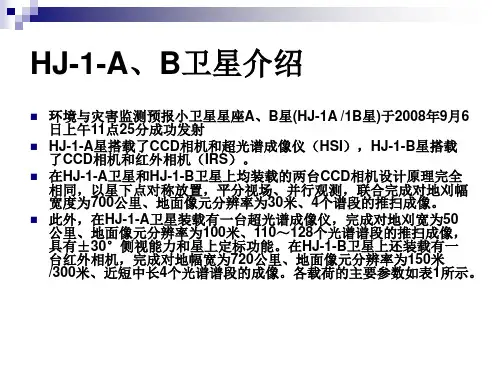

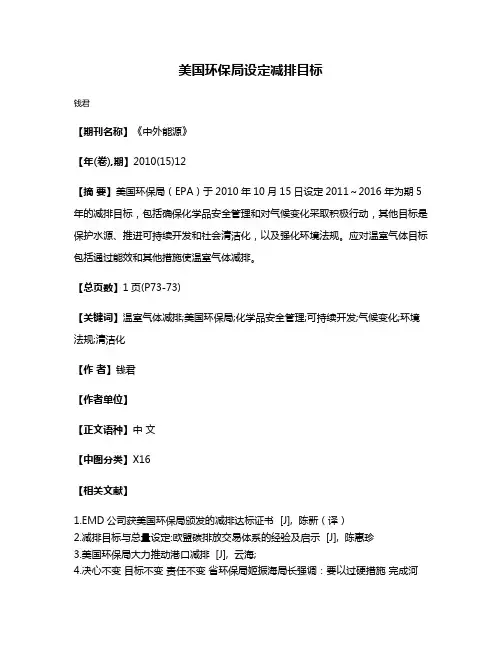
美国环保局设定减排目标
钱君
【期刊名称】《中外能源》
【年(卷),期】2010(15)12
【摘要】美国环保局(EPA)于2010年10月15日设定2011~2016年为期5年的减排目标,包括确保化学品安全管理和对气候变化采取积极行动,其他目标是保护水源、推进可持续开发和社会清洁化,以及强化环境法规。
应对温室气体目标包括通过能效和其他措施使温室气体减排。
【总页数】1页(P73-73)
【关键词】温室气体减排;美国环保局;化学品安全管理;可持续开发;气候变化;环境法规;清洁化
【作者】钱君
【作者单位】
【正文语种】中文
【中图分类】X16
【相关文献】
1.EMD公司获美国环保局颁发的减排达标证书 [J], 陈新(译)
2.减排目标与总量设定:欧盟碳排放交易体系的经验及启示 [J], 陈惠珍
3.美国环保局大力推动港口减排 [J], 云海;
4.决心不变目标不变责任不变省环保局姬振海局长强调:要以过硬措施完成河
北减排任务 [J], 谢文勇
5.国际海事组织设定了更高的GHG减排目标 [J], 黄丽敏(摘译)
因版权原因,仅展示原文概要,查看原文内容请购买。
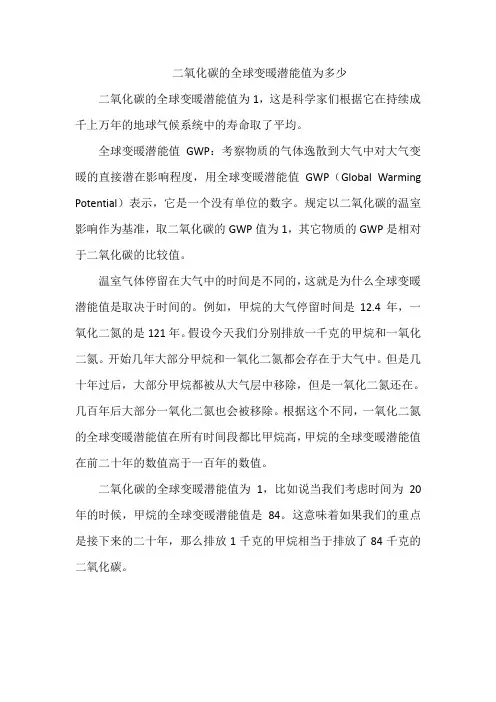
二氧化碳的全球变暖潜能值为多少
二氧化碳的全球变暖潜能值为1,这是科学家们根据它在持续成千上万年的地球气候系统中的寿命取了平均。
全球变暖潜能值GWP:考察物质的气体逸散到大气中对大气变暖的直接潜在影响程度,用全球变暖潜能值GWP(Global Warming Potential)表示,它是一个没有单位的数字。
规定以二氧化碳的温室影响作为基准,取二氧化碳的GWP值为1,其它物质的GWP是相对于二氧化碳的比较值。
温室气体停留在大气中的时间是不同的,这就是为什么全球变暖潜能值是取决于时间的。
例如,甲烷的大气停留时间是12.4年,一氧化二氮的是121年。
假设今天我们分别排放一千克的甲烷和一氧化二氮。
开始几年大部分甲烷和一氧化二氮都会存在于大气中。
但是几十年过后,大部分甲烷都被从大气层中移除,但是一氧化二氮还在。
几百年后大部分一氧化二氮也会被移除。
根据这个不同,一氧化二氮的全球变暖潜能值在所有时间段都比甲烷高,甲烷的全球变暖潜能值在前二十年的数值高于一百年的数值。
二氧化碳的全球变暖潜能值为1,比如说当我们考虑时间为20年的时候,甲烷的全球变暖潜能值是84。
这意味着如果我们的重点是接下来的二十年,那么排放1千克的甲烷相当于排放了84千克的二氧化碳。
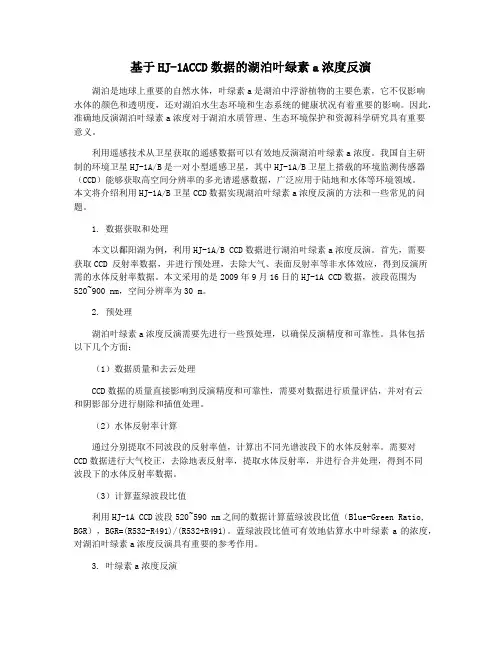
基于HJ-1ACCD数据的湖泊叶绿素a浓度反演湖泊是地球上重要的自然水体,叶绿素a是湖泊中浮游植物的主要色素,它不仅影响水体的颜色和透明度,还对湖泊水生态环境和生态系统的健康状况有着重要的影响。
因此,准确地反演湖泊叶绿素a浓度对于湖泊水质管理、生态环境保护和资源科学研究具有重要意义。
利用遥感技术从卫星获取的遥感数据可以有效地反演湖泊叶绿素a浓度。
我国自主研制的环境卫星HJ-1A/B是一对小型遥感卫星,其中HJ-1A/B卫星上搭载的环境监测传感器(CCD)能够获取高空间分辨率的多光谱遥感数据,广泛应用于陆地和水体等环境领域。
本文将介绍利用HJ-1A/B卫星CCD数据实现湖泊叶绿素a浓度反演的方法和一些常见的问题。
1. 数据获取和处理本文以鄱阳湖为例,利用HJ-1A/B CCD数据进行湖泊叶绿素a浓度反演。
首先,需要获取CCD 反射率数据,并进行预处理,去除大气、表面反射率等非水体效应,得到反演所需的水体反射率数据。
本文采用的是2009年9月16日的HJ-1A CCD数据,波段范围为520~900 nm,空间分辨率为30 m。
2. 预处理湖泊叶绿素a浓度反演需要先进行一些预处理,以确保反演精度和可靠性。
具体包括以下几个方面:(1)数据质量和去云处理CCD数据的质量直接影响到反演精度和可靠性,需要对数据进行质量评估,并对有云和阴影部分进行剔除和插值处理。
(2)水体反射率计算通过分别提取不同波段的反射率值,计算出不同光谱波段下的水体反射率。
需要对CCD数据进行大气校正,去除地表反射率,提取水体反射率,并进行合并处理,得到不同波段下的水体反射率数据。
(3)计算蓝绿波段比值利用HJ-1A CCD波段520~590 nm之间的数据计算蓝绿波段比值(Blue-Green Ratio, BGR),BGR=(R532-R491)/(R532+R491)。
蓝绿波段比值可有效地估算水中叶绿素a的浓度,对湖泊叶绿素a浓度反演具有重要的参考作用。

名词解析碳中和净零排放气候中性喜欢深入了解的朋友可以去翻阅ISO标准和《IPCC指南》的相关正式发布,本文仅作为个人见解和引发关注术语的一致性问题。
知识所限难免错漏,也欢迎讨论和指正~自从2023年我国提出“碳达峰、碳中和”以来,“碳中和”一词一度成为国内最热门的时尚词语和热门话题。
一年以来各种夹杂着“净零排放”、“气候中性”的用法随处可见,不得不仔细分一分、辨一辨。
碳中和来自“Carbon Neutral”、净零排放来自“Net Zero Emission”、气候中性是“Climate Neutral”,这三个词都是从英文翻译过来的。
“碳中和”来自Carbon Neutral的直译,但严格来讲广义的碳中和不单指二氧化碳的中和、而是指n种温室气体的中和,比如主流国际标准PAS2050/ ISO14067 / PAS2060等都提到的是温室气体(Greenhouse gases, GHG),《京都议定书》要求全球管控的是6种。
我们试着想一下:因为温室气体的排放可以按照GWP100折算成二氧化碳当量,所以叫“二氧化碳当量中和”,进而简化成“碳中和”,也有些道理,毕竟我中华语言博大精深。
其实我发现老外也不是每次说到二氧化碳就真的用Carbon Dioxide,有时就用Carbon。
“净零排放”按照Net Zero Emisson直接翻译过来就是字面意思:“没有任何排放”(是先天优势),不是通过抵消手段,不然就跑到碳中和的意思上去了(碳中和是指允许排放但通过抵消手段使排放量计算结果为零,算后天努力),但也有文献把“净零排放”与“碳中和”一词等同使用。
“气候中和”一词由Climate neutral 翻译过来,听起来就很高大上,我也问过老外,他们也觉得“气候中和”的字面意思明显大于“碳中和”,至于为什么也是觉得跟整个地球和宇宙有关。
结合LCA全生命周期评价方法(ISO14040/ISO14044)进行的影响评价结果同时会考虑例如水足迹、臭氧层耗损、酸化、人体毒性影响等方面的这一思路(不仅仅关注温室气体导致的全球增温),所以个人觉得至少这些都做到中和那才叫“气候中和”,气候中和也许是碳中和之后的下一个目标?。
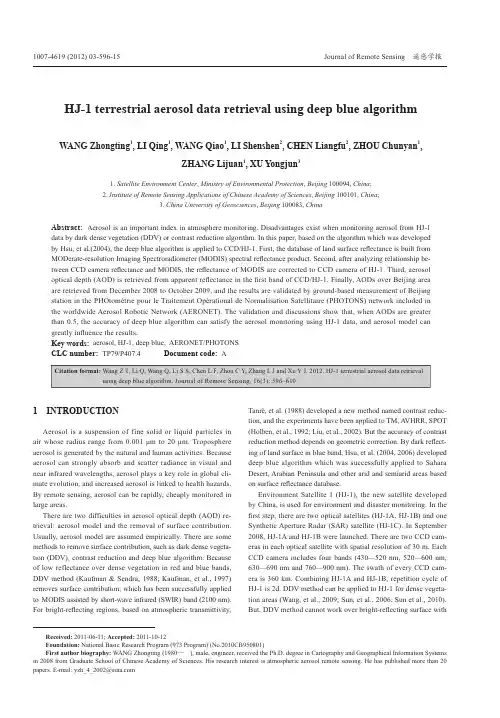
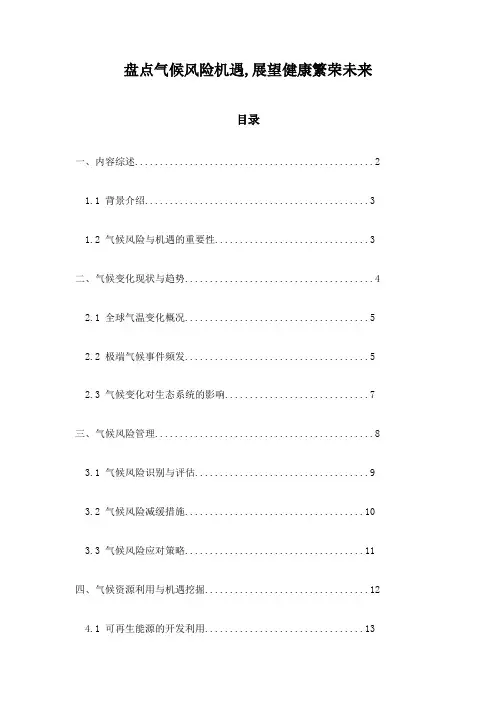
盘点气候风险机遇,展望健康繁荣未来目录一、内容综述 (2)1.1 背景介绍 (3)1.2 气候风险与机遇的重要性 (3)二、气候变化现状与趋势 (4)2.1 全球气温变化概况 (5)2.2 极端气候事件频发 (5)2.3 气候变化对生态系统的影响 (7)三、气候风险管理 (8)3.1 气候风险识别与评估 (9)3.2 气候风险减缓措施 (10)3.3 气候风险应对策略 (11)四、气候资源利用与机遇挖掘 (12)4.1 可再生能源的开发利用 (13)4.2 能源效率提升 (15)4.3 碳捕获与存储技术应用 (16)五、气候适应与健康发展 (17)5.1 城市气候变化适应策略 (18)5.2 农业气候适应技术 (19)5.3 健康生活方式推广 (21)六、气候繁荣未来展望 (22)6.1 气候经济转型与创新 (23)6.2 国际合作与政策支持 (24)6.3 公众参与与社会行动 (25)七、结论与建议 (27)7.1 主要研究发现总结 (28)7.2 对政策制定者的建议 (29)7.3 对未来研究的展望 (30)一、内容综述随着全球气候变化的加剧,气候风险已经成为了影响人类社会和经济发展的重要因素。
在这个背景下,各国政府、企业和社会各界都在积极应对气候变化带来的挑战,寻求可持续发展的新路径。
本文档将对气候风险进行盘点,分析其中的机遇,并展望健康繁荣的未来发展。
我们将对当前全球气候变化的主要趋势进行梳理,包括极端天气事件的增多、海平面上升、生态系统破坏等。
我们将探讨这些气候风险对各个领域的影响,如农业、水资源、能源、基础设施等。
在此基础上,我们将分析各国在应对气候变化方面的政策和措施,以及国际合作的进展。
我们还将关注气候风险带来的机遇,清洁能源产业的发展、低碳技术的创新、绿色建筑的推广等。
这些机遇将有助于推动经济结构调整,促进绿色发展,实现可持续发展目标。
我们还将关注气候风险对人类健康的影响,如极端高温天气导致的中暑、空气污染引发的呼吸道疾病等。
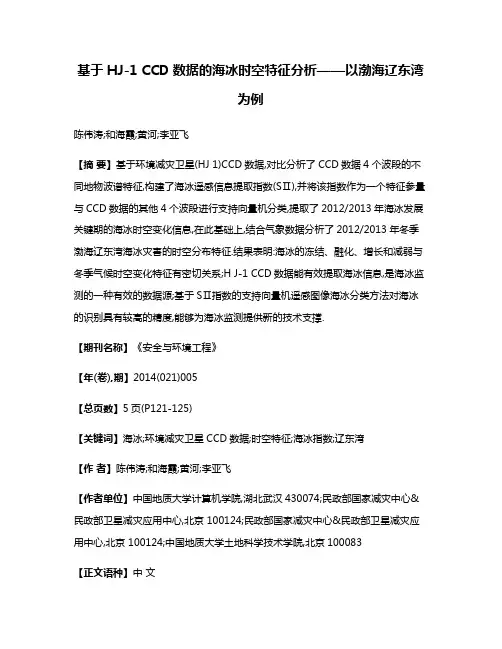
基于HJ-1 CCD数据的海冰时空特征分析——以渤海辽东湾为例陈伟涛;和海霞;黄河;李亚飞【摘要】基于环境减灾卫星(HJ 1)CCD数据,对比分析了CCD数据4个波段的不同地物波谱特征,构建了海冰遥感信息提取指数(SⅡ),并将该指数作为一个特征参量与CCD数据的其他4个波段进行支持向量机分类,提取了2012/2013年海冰发展关键期的海冰时空变化信息,在此基础上,结合气象数据分析了2012/2013年冬季渤海辽东湾海冰灾害的时空分布特征.结果表明:海冰的冻结、融化、增长和减弱与冬季气候时空变化特征有密切关系;H J-1 CCD数据能有效提取海冰信息,是海冰监测的一种有效的数据源;基于SⅡ指数的支持向量机遥感图像海冰分类方法对海冰的识别具有较高的精度,能够为海冰监测提供新的技术支撑.【期刊名称】《安全与环境工程》【年(卷),期】2014(021)005【总页数】5页(P121-125)【关键词】海冰;环境减灾卫星CCD数据;时空特征;海冰指数;辽东湾【作者】陈伟涛;和海霞;黄河;李亚飞【作者单位】中国地质大学计算机学院,湖北武汉430074;民政部国家减灾中心&民政部卫星减灾应用中心,北京 100124;民政部国家减灾中心&民政部卫星减灾应用中心,北京 100124;中国地质大学土地科学技术学院,北京100083【正文语种】中文【中图分类】X87;X43海冰是一种严重的海洋自然灾害,其危害主要表现在两个方面:①海冰的存在影响海、气热交换过程[1],进而影响海洋生态和海洋生物[2],导致大量养殖海产品因缺氧死亡,造成严重的经济损失[3],如2010 年中国渤海和黄海北部遭遇到近30年来最严重的海冰冰情,海水养殖受损面积达20.8 万hm2[4] ,直接经济损失达63.18 亿元;②海冰严重影响油气勘探等海上工程设施和海上航运,导致石油平台倒塌、船舶受损、航运受阻等,严重威胁资源财产和人身安全[5]。
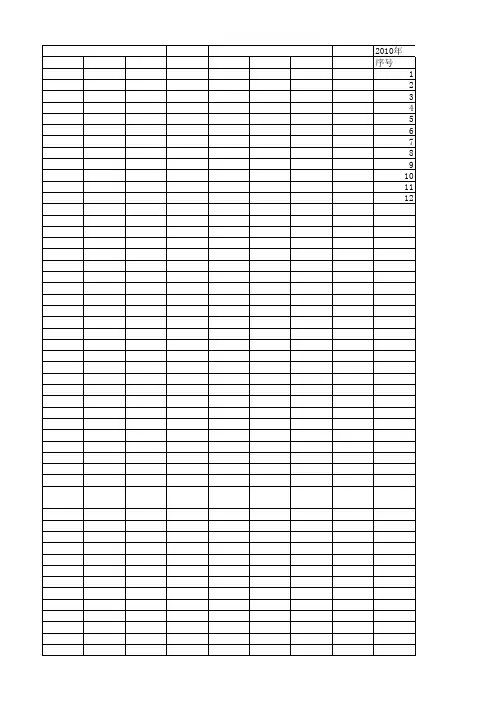
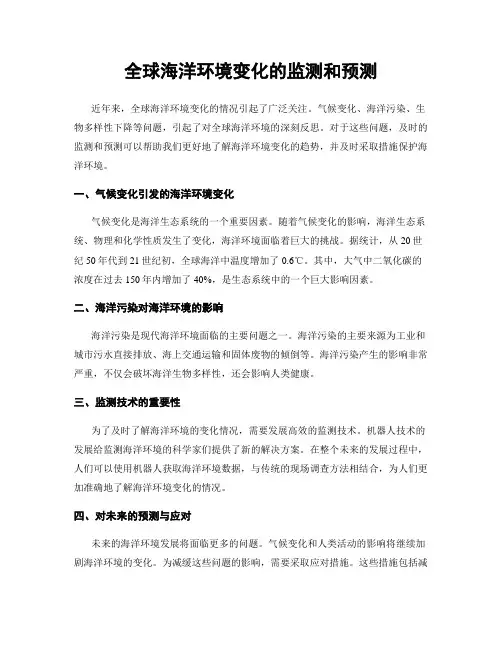
全球海洋环境变化的监测和预测近年来,全球海洋环境变化的情况引起了广泛关注。
气候变化、海洋污染、生物多样性下降等问题,引起了对全球海洋环境的深刻反思。
对于这些问题,及时的监测和预测可以帮助我们更好地了解海洋环境变化的趋势,并及时采取措施保护海洋环境。
一、气候变化引发的海洋环境变化气候变化是海洋生态系统的一个重要因素。
随着气候变化的影响,海洋生态系统、物理和化学性质发生了变化,海洋环境面临着巨大的挑战。
据统计,从20世纪50年代到21世纪初,全球海洋中温度增加了0.6℃。
其中,大气中二氧化碳的浓度在过去150年内增加了40%,是生态系统中的一个巨大影响因素。
二、海洋污染对海洋环境的影响海洋污染是现代海洋环境面临的主要问题之一。
海洋污染的主要来源为工业和城市污水直接排放、海上交通运输和固体废物的倾倒等。
海洋污染产生的影响非常严重,不仅会破坏海洋生物多样性,还会影响人类健康。
三、监测技术的重要性为了及时了解海洋环境的变化情况,需要发展高效的监测技术。
机器人技术的发展给监测海洋环境的科学家们提供了新的解决方案。
在整个未来的发展过程中,人们可以使用机器人获取海洋环境数据,与传统的现场调查方法相结合,为人们更加准确地了解海洋环境变化的情况。
四、对未来的预测与应对未来的海洋环境发展将面临更多的问题。
气候变化和人类活动的影响将继续加剧海洋环境的变化。
为减缓这些问题的影响,需要采取应对措施。
这些措施包括减少化石燃料的消耗、降低二氧化碳的排放、加强对海洋污染的管控和研发更多环保技术。
总之,海洋环境变化是一个全球性的问题。
实现对海洋环境的监测和预测,有助于更好地保护我们的海洋环境。
在未来的发展过程中,我们需要抱团而行,共同做好海洋环境的保护工作,为我们人类、动物和海洋的健康和繁荣做出贡献。
基于HJ-1ACCD数据的湖泊叶绿素a浓度反演湖泊叶绿素a浓度是衡量水体藻类生长和水质的重要指标之一,对于湖泊生态环境的监测和保护具有重要意义。
传统的叶绿素a浓度监测方式需要耗费大量人力物力进行野外调查和实验室分析,费时费力。
而基于遥感数据的叶绿素a浓度反演方法可以大大提高监测效率和准确性,成为了当前研究的热点之一。
HJ-1A和HJ-1B,它们分别搭载有多光谱和全色相机,能够获取30米分辨率的多光谱和16米全色影像数据。
这使得HJ-1星系列数据成为了进行叶绿素a浓度反演研究的理想选择。
本文将基于HJ-1ACCD数据进行湖泊叶绿素a浓度反演的研究,以期为湖泊水质监测提供更为高效、精确的方法。
一、HJ-1ACCD数据HJ-1ACCD是由环境卫星应用与服务中心提供的一种遥感产品数据,其数据涵盖了中国大陆及周边地区的陆地环境、植被和农田等多种信息。
HJ-1ACCD数据以HJ-1A/B卫星的CCD传感器为基础,通过对CCD传感器数据的预处理和气象校正,生成了表征地表反射率和植被生长状况的遥感产品,包括植被指数、叶绿素含量等。
二、湖泊叶绿素a浓度反演方法1.建立叶绿素a浓度与遥感数据的定量关系模型我们需要采集湖泊水体的实地采样数据,包括叶绿素a浓度、水体颜色、透明度等指标。
然后,利用HJ-1ACCD数据获取湖泊水体的遥感信息,如反射率、光谱特征等。
接着,利用统计学方法或机器学习算法建立叶绿素a浓度与遥感数据之间的定量关系模型,例如多元线性回归模型、支持向量机模型等。
2.验证模型准确性建立模型后,需要对其进行验证,以验证模型的准确性和可靠性。
可以利用另外采集的实地数据进行验证,或者采用交叉验证等方法进行模型验证。
3.应用模型进行叶绿素a浓度反演一旦模型验证通过,就可以将模型应用于湖泊叶绿素a浓度的遥感反演工作中。
利用HJ-1ACCD数据获取的遥感信息,输入到建立的模型中,就可以得到湖泊叶绿素a浓度的反演结果。
基于HJ-1ACCD数据的湖泊叶绿素a浓度反演湖泊是地球上重要的淡水资源,叶绿素a浓度是湖泊水质的重要指标之一。
利用卫星遥感数据进行湖泊叶绿素a浓度的反演,可以实现对大范围湖泊水质的监测和评估,对于湖泊环境管理具有重要的意义。
本文将介绍基于HJ-1ACCD数据的湖泊叶绿素a浓度反演研究。
1. 研究背景湖泊是淡水资源的重要蓄水库,但受到人类活动和自然因素的影响,湖泊水质普遍面临着恶化的问题。
叶绿素a是湖泊中浮游植物的主要色素,其浓度可以反映湖泊的营养状态和水质状况。
对于叶绿素a浓度的监测和评估具有重要的意义,可以为湖泊的环境管理和保护提供科学依据。
传统的湖泊水质监测方法主要依靠定点取样和实地分析,由于湖泊的面积广阔和复杂性,这种方法存在取样点有限、时空分辨率不高等局限性。
而卫星遥感技术能够实现对大范围湖泊的监测,并具有较高的时空分辨率和覆盖范围,因此成为湖泊水质监测的重要手段。
2. HJ-1ACCD数据简介HJ-1ACCD是中国环境遥感卫星的一种载荷,具有较高的光谱分辨率和较好的辐射校正精度,适合于湖泊水质参数的遥感反演。
其辐射范围包括可见光和近红外光谱段,能够有效获取湖泊水体的光学特征参数。
HJ-1ACCD数据具有较高的时空分辨率,可实现对湖泊水体的连续监测和观测。
由于其具有较好的辐射校正精度,因此适合于湖泊叶绿素a浓度的反演研究。
3. 湖泊叶绿素a浓度反演方法湖泊叶绿素a浓度的反演主要基于遥感数据和反演模型。
利用HJ-1ACCD数据获取湖泊水体的光学特征参数,如反射率、吸收系数等,然后根据这些参数构建叶绿素a浓度的反演模型,并通过模型反演获取湖泊的叶绿素a浓度信息。
在构建叶绿素a浓度的反演模型时,需要考虑到湖泊水体的光学特征和颗粒物的影响。
在实际应用中,常常采用基于光学特征的经验模型或基于统计方法的经验模型来进行叶绿素a浓度的反演,同时结合地面取样数据进行验证和修正,以提高模型的准确性和适用性。
第一章地球环境的基本特征什么是环境?环境是相对于中心事物而言的,与某一中心事物有关的事物,就是这个中心事物的环境。
环境科学研究的环境,是以人类为主体的外部世界,即人类赖以生存和发展的物质条件的综合体。
环境的分类地球及自然环境特征1,地球及其自然环境运动的普遍性2,地球及其自然环境分层的普遍性3,地球及其自然环境演进的普遍性1,地球及其自然环境运动的普遍性太阳系尺度:公转星际尺度:自转地球尺度:板块运动圈际尺度:碳循环、水循环圈层尺度:食物链中的能量流动圈层际间的运动——物质循环水循环,磷循环,氮循环,碳循环2,地球及其自然环境分层的普遍性地球尺度的分层―四大圈层大气圈,水圈,生物圈,岩石圈圈内分层―大气圈热层―中间层―平流层―对流层人类与地球各圈层的关系大气圈因地球引力而聚集在地表周围的气体圈层,是地球最外部的一个圈层。
大气是人类和生物赖以生存必不可少的物质条件,也是使地表保持恒温和水分的保护层,同时也是促进地表形态变化的重要动力和媒介。
水圈由地球表层水体所构成的连续圈层。
水是组成自然界最重要的物质之一,是一切生物生存必不可少的物质条件,对地球表层环境的形成和改造起到重要的作用。
陆地水和海洋水是水圈的两大组成部分。
它们的物质成分和物理性质是有差别的。
陆地水在体积上和质量上虽然比海洋水小得多,但它们广泛分布于陆地上,对陆地地形的改变起着重要作用。
生物圈地球表层由生物及其生命活动的地带所构成的连续圈层,是地球上生物生存和活动的范围,是地球上所有生物及其生存环境的总称。
它同大气圈、水圈和岩石圈的表层相互渗透、相互影响、相互交错分布,它们之间没有一条绝然的分界线。
生物圈所包括的范围是以生物存在和生命活动为标准的,从地表以下3km 到地表以上10 多公里的高空以及深海的海底都属于生物圈的范围,但是生物圈中的90 %以上的生物都活动在地表到200m 高空以及从水面到水下200m 的水域空间内。
土壤圈土壤是由岩石风化后在其他各种条件的作用下逐步形成的。
Climate Change Effects on Insects and PathogensCurtis PetzoldtAssistant Director and Vegetable IPM Coordinator(cp13@)andAbby SeamanArea Extension Educator, WNY Vegetable IPM(ajs32@)New York State IPM Program, 630 W. North St.,New York State Agricultural Extension Station,Geneva, NY 14456General BackgroundPlant pathogens, crop hosts and the environmentThe study of plant disease often begins with a discussion of the “plant disease triangle”.The three legs of the triangle – host, pathogen, and environment – must be present and interact appropriately for plant disease to result. If any of the 3 factors is altered, changes in the progression of a disease epidemic can occur. The major predicted results of climate change – increases in temperature, moisture and CO2 – can impact all three legs of the plant disease triangle in various ways. Precisely predicting the impact of climate change on plant disease is tricky business.How rising temperatures will affect pathogens and diseaseTemperature has potential impacts on plant disease through both the host crop plant and the pathogen. Research has shown that host plants such as wheat and oats become more susceptible to rust diseases with increased temperature; but some forage species become more resistant to fungi with increased temperature (Coakley et al 1999). Many mathematical models that have been useful for forecasting plant disease epidemics are based on increases in pathogen growth and infection within specified temperature ranges. Generally, fungi that cause plant diseasegrow best in moderate temperature ranges. Temperate climate zones that include seasons with cold average temperatures are likely to experience longer periods of temperatures suitable for pathogen growth and reproduction if climates warm. For example, predictive models for potato and tomato late blight (caused by Phytophthora infestans) show that the fungus infects and reproduces most successfully during periods of high moisture that occur when temperatures are between 45o F (7.2 o C) and 80 o F (26.8 o C) (Wallin et al 1950). Earlier onset of warm temperatures could result in an earlier threat from late blight with the potential for more severe epidemics and increases in the number of fungicide applications needed for control.How changes in moisture will affect pathogens and diseaseMoisture can impact both host plants and pathogen organisms in various ways. Some pathogens such as apple scab, late blight, and several vegetable root pathogens are more likely to infect plants with increased moisture – forecast models for these diseases are based on leaf wetness, relative humidity and precipitation measurements. Other pathogens like the powdery mildew species tend to thrive in conditions with lower (but not low) moisture.More frequent and extreme precipitation events that are predicted by some climate change models could result in more and longer periods with favorable pathogen environments. Host crops with canopy size limited by lack of moisture might no longer be so limited and may produce canopies that hold moisture in the form of leaf wetness or high canopy relative humidity for longer periods, thus increasing the risk from pathogen infection (Coakley et al 1999). Some climate change models predict higher atmospheric water vapor concentrations with increased temperature – this also would favor pathogen and disease development.How rising CO2 levels will affect pathogens and diseaseIncreased CO2 levels can impact both the host and the pathogen in multiple ways. Some of the observed CO2 effects on disease may counteract others. Researchers have shown that higher growth rates of leaves and stems observed for plants grown under high CO2 concentrations may result in denser canopies with higher humidity that favor pathogens. Lower plant decomposition rates observed in high CO2 situations could increase the crop residue on which disease organisms can overwinter, resulting in higher inoculum levels at the beginning of the growing season, and earlier and faster disease epidemics. Pathogen growth can be affected by higher CO2 concentrations resulting in greater fungal spore production. However, increased CO2 can result in physiological changes to the host plant that can increase host resistance to pathogens (Coakley et al 1999).How climate change could impact plant disease management practicesWhile physiological changes in host plants may result in higher disease resistance under climate change scenarios, host resistance to disease may be overcome more quickly by more rapid disease cycles, resulting in a greater chance of pathogens evolving to overcome host plant resistance. Fungicide and bactericide efficacy may change with increased CO2, moisture, and temperature. The more frequent rainfall events predicted by climate change models could result in farmers finding it difficult to keep residues of contact fungicides on plants, triggering more frequent applications. Systemic fungicides could be affected negatively by physiological changes that slow uptake rates, such as smaller stomatal opening or thicker epicuticular waxes in crop plants grown under higher temperatures. These same fungicides could be affected positively by increased plant metabolic rates that could increase fungicide uptake. It is not wellunderstood how naturally-occurring biological control of pathogens by other microbial organisms could change as populations of microorganisms shift under changed temperature and moisture regimes – in some cases antagonistic organisms may out-compete pathogens while in others pathogens may be favored. Exclusion of pathogens and quarantines through regulatory means may become more difficult for authorities as unexpected pathogens might appear more frequently on imported crops.How this will affect farmersAlthough the specific impacts of climate change on plant disease are difficult to predict given our current knowledge, it seems possible to make several generalizations for farmers in the northeastern US: a) increased winter temperatures will likely mean higher populations of pathogens survive to initially infect plants; b) increased temperatures will likely result in northward expansion of the range of some diseases because of earlier appearance and more generations of pathogens per season; c) more frequent and more intense rainfall events will tend to favor some types of pathogens over others (Coakley et al 1999). Two pathogens important in the northeastern US, Stewart’s wilt and late blight, illustrate some of these effects. Stewart’s wilt, a bacterial (Erwinia stewartii) disease of generally sporadic importance in sweet corn in the northeast, is vectored by the corn flea beetle (Chaetocnema pulicaria). Survival of the vector through winter is considered key to the severity of Stewart’s wilt infections the following year. Currently, a forecast model based on winter temperatures is used to predict severity for Stewart’s wilt. The model assumes the survival of the corn flea beetle is higher in warmer winters than colder winters (Castor et al 1975). Climate change resulting in more winters that allow larger populations of flea beetles to survive would be expected to increase the frequency of growing seasons with severe Stewart’s wilt.Stewart’s wilt (transmitted by the corn flea beetle) frequency may be increased by climate change (flea beetle from Shelton - /ent/factsheets/pests/cornfb.html;Stewart’s wilt from Petzoldt)Farmers in the northeastern US now attempt to control Stewart’s wilt by planting resistant varieties and using in-furrow or foliar insecticides to control the flea beetle vector (Stivers 1999, Fournier 1999, Whitney et al 2000, Baniecki and Dabaam 2000). Farmers would incur increased costs as a result of increased frequency of insecticide treatment and the accompanying negative environmental impacts would mount. Resistant varieties are the most effective method for Stewart’s wilt control, yet few varieties offer high levels of resistance and some popular varieties offer only moderate or low levels of resistance (Stivers 1999a, Fournier1999, Whitney et al 2000, Baniecki and Dabaam 2000a). Higher levels of Stewart’s wilt in more growing seasons could impact farmers’ variety selection forcing them to choose varieties based on Stewart’s wilt resistance rather than market qualities such as taste, texture, and appearance. Farmers’ profitability could thus be impacted by the varieties they would be forced to grow to combat Stewart’s wilt.Late blight (Phytopthora infestans) infects both potatoes and tomatoes in the northeastern US. It can be a devastating disease for both crops and farmers, with complete crop loss a possibility if control measures are not employed. Infection is triggered by high moisture conditions within a fairly specific temperature range. Annually, 5-20 fungicide applications from as early as June through August are used in the northeastern US (Stivers 1999b, Hoffman 1999. Baniecki and Dabaam 2000b). This represents a significant expense to farmers and a significant environmental risk. Work in Finland, which is considered to be in a similar late blight risk zone to the northeastern US (Hijmans 2000), has predicted that for each 1 C warming late blight would occur 4 to 7 days earlier, and the susceptibility period extended by 10 to 20 days (Kaukoranta 1996). This would likely translate into an additional 1 to 4 additional fungicide applications for northeastern US potato farmers – increasing both farmer costs and environmental risk.Late blight severity and control costs may be increased by climate change. (Late blight from Fry)Insects and the environmentInsects are cold-blooded organisms - the temperature of their bodies is approximately the same as that of the environment. Therefore, temperature is probably the single most important environmental factor influencing insect behavior, distribution, development, survival, and reproduction. Insect life stage predictions are most often calculated using accumulated degree days from a base temperature and biofix point. Some researchers believe that the effect of temperature on insects largely overwhelms the effects of other environmental factors (Bale et al 2002). It has been estimated that with a 2o C temperature increase insects might experience one to five additional life cycles per season (Yamamura & Kiritani 1998). Other researchers have found that moisture and CO2 effects on insects can be potentially important considerations in a global climate change setting (Hamilton 2005, Coviella and Trumble 1999, Hunter 2001).How rising temperatures affect insectsClimate change resulting in increased temperature could impact crop pest insect populations in several complex ways. Although some climate change temperature effects might tend to depress insect populations, most researchers seem to agree that warmer temperatures in temperate climates will result in more types and higher populations of insects.Increased temperature could increase pest insect populationsResearchers have shown that increased temperatures can potentially affect insect survival, development, geographic range, and population size. Temperature can impact insect physiology and development directly or indirectly through the physiology or existence of hosts. Depending on the development “strategy” of an insect species, temperature can exert different effects (Bale et al 2002). Some insects take several years to complete one life cycle – these insects (cicadas, arctic moths) will tend to moderate temperature variability over the course of their life history. Some crop pests are “stop and go” developers in relation to temperature – they develop more rapidly during periods of time with suitable temperatures. We often use degree-day or phenology based models to predict the emergence of these insects and their potential to damage crops (cabbage maggot, onion maggot, European corn borer, Colorado potato beetle). Increased temperatures will accelerate the development of these types of insects – possibly resulting in more generations (and crop damage) per year.“Migratory” insects (corn earworm in northern parts of the northeast) may arrive in the Northeast earlier, or the area in which they are able to overwinter may be expanded. Natural enemy and host insect populations may respond differently to changes in temperature. Parasitism could be reduced if host populations emerge and pass through vulnerable life stages before parasitoids emerge. Hosts may pass though vulnerable life stages more quickly at higher temperatures, reducing the window of opportunity for parasitism. Temperature may change gender ratios of some pest species such as thrips (Lewis 1997) potentially affecting reproduction rates. Insects that spend important parts of their life histories in the soil may be more gradually affected by temperature changes than those that are above ground simply because soil provides an insulating medium that will tend to buffer temperature changes more than the air (Bale et al 2002).Lower winter mortality of insects due to warmer winter temperatures could be important in increasing insect populations (Harrington et al. 2001). Higher average temperature might result in some crops being able to be grown in regions further north – it is likely that at least some of the insect pests of those crops will follow the expanded crop areas. Insect species diversity per area tends to decrease with higher latitude and altitude (Gaston & Williams 1996, Andrew & Hughes 2005), meaning that rising temperatures could result in more insect species attacking more hosts in temperate climates (Bale et al 2002). Based on evidence developed by studying the fossil record some researchers (Bale et al 2002) conclude that the diversity of insect species and the intensity of their feeding have increased historically with increasing temperature. Increased temperature could decrease pest insect populationsSome insects are closely tied to a specific set of host crops. Temperature increases that cause farmers not to grow the host crop any longer would decrease the populations of insect pests specific to those crops. The same environmental factors that impact pest insects can impacttheir insect predators and parasites as well as the disease organisms that infect the pests, resulting in increased attack on insect populations. At higher temperatures, aphids have been shown to be less responsive to the aphid alarm pheromone they release when under attack by insect predators and parasitoids – resulting in the potential for greater predation. (Awmack et al 1997).How changes in precipitation will affect insectsThere are fewer scientific studies on the effect of precipitation on insects than temperature. Some insects are sensitive to precipitation and are killed or removed from crops by heavy rains - in some northeastern US states, this consideration is important when choosing management options for onion thrips (Reiners and Petzoldt 2005). For some insects that overwinter in soil, such as the cranberry fruitworm and other cranberry insect pests, flooding the soil has been used as a control measure (Vincent et al 2003). One would expect the predicted more frequent and intense precipitation events forecasted with climate change to negatively impact these insects. Other insects such as pea aphids are not tolerant of drought (Macvean and Dixon 2001). As with temperature, precipitation changes can impact insect pest predators, parasites, and diseases resulting in a complex dynamic. Fungal pathogens of insects are favored by high humidity and their incidence would be increased by climate changes that lengthen periods of high humidity and reduced by those that result in drier conditions.How rising CO2 levels affect insectsGenerally CO2 impacts on insects are thought to be indirect - impact on insect damage results from changes in the host crop. Some researchers have found that rising CO2 can potentially have important effects on insect pest problems. Recently, free air gas concentration enrichment (FACE) technology was used to create an atmosphere with CO2 and O2 concentrations similar to what climate change models predict for the middle of the 21st century. FACE allows for field testing of crop situations with fewer limitations than those conducted in enclosed spaces. During the early season, soybeans grown in elevated CO2 atmosphere had 57% more damage from insects (primarily Japanese beetle, potato leafhopper, western corn rootworm and Mexican bean beetle) than those grown in today’s atmosphere, and required an insecticide treatment in order to continue the experiment. It is thought that measured increases in the levels of simple sugars in the soybean leaves may have stimulated the additional insect feeding (Hamilton et al. 2005).Although not observed in the FACE study, other researchers have observed that insects sometimes feed more on leaves that have a lowered nitrogen content in order to obtain sufficient nitrogen for their metabolism (Coviella and Trumble 1999, Hunter 2001). Increased carbon to nitrogen ratios in plant tissue resulting from increased CO2 levels may slow insect development and increase the length of life stages vulnerable to attack by parasitoids (Coviella and Trumble. 1999).How this will affect farmersIt is likely that farmers will experience extensive impacts on insect management strategies with changes in climate. Entomologists expect that insects will expand their geographic ranges, and increase reproduction rates and overwintering success. This means that it is likely that farmers in the northeastern US will have more types and higher numbers of insects to manage. Basedon current comparisons of insecticide usage between more southern states and more northern states, this is likely to mean more insecticide use and expense for northeastern farmers. New York conditions currently require 0-5 insecticide applications against lepidopteran insect pests to produce marketable sweet corn (Stivers 1999a); Maryland and Delaware conditions require 4-8 insecticide applications (Fournier 1999, Whitney et al. 2000); Florida conditions require 15-32 applications (Aerts et al, 1999). It is apparent that for sweet corn pests, warmer temperatures translate to increased insecticide applications to produce a marketable crop. Insecticides and their applications have significant economic costs for growers and environmental costs for society. Additionally, some classes of pesticides (pyrethroids and spinosad) have been shown to be less effective in controlling insects at higher temperatures (Musser & Shelton 2005).Entomologists predict additional generations of important pest insects in temperate climates as a result of increased temperatures, probably necessitating more insecticide applications to maintain populations below economic damage thresholds. A basic rule of thumb for avoiding the development of insecticide resistance is to apply insecticides with a particular mode of action less frequently (Shelton et al 2001, Georghiou and Taylor 1986). With more insecticide applications required, the probability of applying a given mode of action insecticide more times in a season will increase, thus increasing the probability of insects developing resistance to insecticides.In New York a network of pheromone traps in sweet corn fields has been used to monitor corn earworm (Helicoverpa zea) throughout the central and western part of the state for over 10 years (Seaman personal communication). Corn earworm is thought not to overwinter in upstate New York and is generally considered to be a late season, migratory pest of sweet corn, so trapping was initiated in mid-July. The graphs in Figure 1 compare the trap catches in 1995 with those in 2003 in Eden Valley, NY.earwormlarvaCornadultearwormCorn(Corn earworm from Seaman)Figure 1: trap catch data indicating possible over wintering of corn earworm in western NY During the early years of the trap network, CEW traps remained empty until mid-late August. After an unexpected early season infestation in Eden in 1999 trapping was initiated in early June, and typically, low levels of moths are caught through the early season, increasing when the migratory flight arrives. It is yet to be determined if the earlier arrival of corn earworm indicates it is overwintering in Eden, but since CEW management recommendations are based on trap catches, it is clear that control of this pest is already costing farmers more than it did nine years ago.A number of cultural practices that can be used by farmers could be affected by changes in climate – although it is not clear whether these practices would be helped, hindered, or not affected by the anticipated changes. Using crop rotation as an insect management strategy could be less effective with earlier insect arrival or increased overwintering of insects. However, this could be balanced by changes in the earliness of crop planting times, development, and harvest. Row covers used for insect exclusion might have to be removed earlier to prevent crop damage by excessive temperatures under the covers – would the targeted early insects also complete their damaging periods earlier or be ready to attack when the row covers were removed?What farmers can do to adaptFarmers should keep in mind that climate change is likely to be a gradual process that will give them some opportunity to adapt. Although changes in our northeastern US climate are almost certainly happening, it is not precisely understood how these changes will affect crops, insects, diseases, and the relationships among them. If climate is warmer will increases in yield offset losses to pests, or will losses to pests outweigh yield advantages from warmer temperatures? It is likely that new pests will become established in more northerly areas and be able attack plants in new regions. It is likely that plants in some regions will be attacked more frequently by certain pests. A few pests may be less likely to attack crops as change occurs. It is likely that we will not know the actual impacts of climate change on pests until they occur. Clearly, it will be important for farmers to be aware of crop pest trends in their region and flexible in choosing both their management methods and in the crops they grow. Farmers who closely monitor the occurrence of pests in their fields and keep records of the severity, frequency, and cost of managing pests over time will be in a better position to make decisions about whether it remains economical to continue to grow a particular crop or use a certain pest management technique. If more fungicide or insecticide applications are required in order to successfullygrow a particular crop, farmers will need to carefully evaluate whether growing that crop remains economical. Those farmers who make the best use of the basics of integrated pest management (IPM) such as field monitoring, pest forecasting, recordkeeping, and choosing economically and environmentally sound control measures will be most likely to be successful in dealing with the effects of climate change.Summary• The precise impacts of climate change on insects and pathogens is somewhat uncertain because some climate changes may favor pathogens and insects while others may inhibit a few insects and pathogens.The preponderance of evidence indicates that there will be an overall increase in the number of outbreaks of a wider variety of insects and pathogens.• The possible increased use of fungicides and insecticides resulting from an increase in pest outbreaks will likely have negative environmental and economic impacts for agriculture in the northeastern US.• The best economic strategy for farmers to follow is to use integrated pest management practices to closely monitor insect and disease occurrence. Keeping pest and crop management records over time will allow farmers to evaluate the economics and environmental impact of pest control and determine the feasibility of using certain pest management strategies or growing particular crops.ReferencesDisease references:Castor, L.L., J.E. Ayers, A.A. McNabb, R.A. Krause. 1975. Computerized forecast system for Stewart’s bacterial disease on corn. Plant Dis. Rep. 59:533-536.Chakraborty, S., A.V. Tiedemann, P.S. Teng. 2000. Climate Change: Potential impact on plant diseases. Environ. Poll. 108:317-326Coakley,S.M., H. Scherm, S. Chakraborty. 1999. Climate Change and Disease Management. Ann. Rev. Phyto. 37:399-426.Harvell, C.D., C.E. Mitchell, J. Ward, S. Altizer, A.P. Dobson, R.S. Ostfeld, M.D. Samuel. 2002. Climate Warming and Disease Risks for Terrestrial and Marine Biota. Science 296:2158-2162.Hijmans, R.J., G.A. Forbes, and T.S. Walker. 2000. Estimating the global severity of potato late blight with GIS-linked disease forecast models. Plant Path. 49:697-705.Kaukoranta, T. 1996. Impact of global warming on potato late blight: risk, yield loss, and control. Agric. Food Sci. Finl. 5:311-327.Wallin,J.R. and P.E. Waggoner. 1950. The influence of climate on the development and spread of Phytophthora infestans in artificially inoculated potato plots. Plant Dis. Reptr. Suppl. 190. pp 19-33.Insect references:Andrew, N.R. and L. Hughes. 2005. Diversity and assemblage structure of phytophagous Hemiptera along a latitudinal gradient: predicting the potential impacts of climate change. Global Ecol Biogeogr. 14:249-262.Awmack, C.S., C.M. Woodcock and R. Harrington. 1997. Climate change may increase vulnerability of aphids to natural enemies. Ecological Entomology. 22:366-368.Bale, J.S. G.J. Masters, I.D. Hodkinson, C. Awmack, T.M. Bezemer, V.K. Brown, J. Butterfield, A. Buse, J.C. Coulson, J. Farrar, J.E.G. Good, R. Harrington, S. Hartley, T.H. Jones. R.L. Lindroth, M.C. Press, I. Symrnioudis, A.D. Watt, and J.B. Whittaker. 2002. Herbivory in global climate change research: direct effects of rising temperatures on insect herbivores. Global Change Biology 8:1-16.Cannon, R.J. 1998. The implications of predicted climate change for insect pests in the UK, with emphasis on non-indigenous species. 4:785-796.Coviella, C. and J. Trumble. 1999. Effects of elevated atmospheric carbon dioxide on insect-plant interactions. Conserv. Biol. 13:700-712.Gaston,K.J. and P.H. Williams. 1996. Spatial patterns in taxonomic diversity. In: Biodiversity 202-229. Blackwell Science, Oxford.Georghiou, G.P. and Taylor, C.E. 1986. Factors influencing the evolution of resistance. In: Pesticide Resistance: Strategies and tactics for management. National Research Council, National Academy Press. Pages 143-157.Hamilton, J.G., O. Dermody, M. Aldea, A.R. Zangerl, A. Rogers, M.R. Berenbaum, and E. Delucia. 2005. Anthropogenic Changes in Tropospheric Composition Increase Susceptibility of Soybean to Insect Herbivory. Envirn. Entomol. 34:2 479-485.Harrington, R., R, Fleming, I. P. Woiwood. 2001. Climate change impacts on insect management and conservation in temperate regions: can they be predicted? Agricultural and Forest Entomology 3:233-240.Hunter, M.D. 2001. Effects of elevated atmospheric carbon dioxide on insect-plant interactions. Ag. Forest. Entomol. 3:153-159.Lewis, T. 1997. Thrips as crop pests. CAB International, Cambridge: University Press. 740 pp.Mcvean, R. and A. F. G. Dixon. 2001. The effect of plant drought-stress on populations of the pea aphid Acyrthosiphon pisum. Ecol. Entomol. 26: 440-443.Climate Change and Agriculture: Promoting Practical and Profitable Responses Musser, F. P and A. M. Shelton. 2005. The influence of post-exposure temperature on the toxicity of insecticides to Ostrinia nubilalis (Lepidoptera:Crambidae). Pest Manag Sci. 61:508-510.Reiners, S and C. Petzoldt (eds). 2005. Integrated Crop and Pest Management Guidelines for Commercial Vegetable Production. Cornell Cooperative Extension publication #124VG /recommends/Shelton, A.M., W.R. Wilsey, and D.M. Soderlund. 2001. Classification of insecticides and acaricides for resistance management. Dept. of Entomology, NYSAES, Geneva, NY 14456. 315-787-2352. /ent/faculty/shelton/pdf/res_mgmt.pdfVincent, C., G. Hallman, B. Panneton, and F. Fleurat-Lessardú. 2003. Management of agricultural insects with physical control methods. Ann Rev Entomol 48: 261-281.Yamamura, K. and K. Kiritani. 1998. A simple method to estimate the potential increase in the number of generations under global warming in temperate zones. Appl. Ent. and Zool. 33:289-298.Both insect and disease references:Aerts, M., P. Cockrell, G. Nuessly, R. Raid, T. Schueneman, and D. Seal. 1999. Crop Profile for Corn (Sweet) in Florida. /CropProfiles/docs/FLcorn-sweet.html Baniecki, J. and M. Dabaan. 2000a. Crop Profile for Corn (sweet) in West Virginia./CropProfiles/docs/wvcorn-sweet.htmlBaniecki, J. and M. Dabaan. 2000b. Crop Profile for Potatoes in West Virginia./CropProfiles/docs/WVpotatoes.htmlFournier, A. 1999. Crop Profile for Corn (sweet) in Maryland./CropProfiles/docs/MDcorn-sweet.htmlHoffman, B. 1999. Crop Profile for Potatoes in Pennsylvania./CropProfiles/docs/papotatoes.htmlStivers, L. 1999a. Crop Profile for Corn (sweet) in New York./cropprofiles/docs/nycorn-sweet.htmlStivers, L. 1999b. Crop Profile for Potatoes in New York./CropProfiles/docs/nypotatoes.htmlWhitney, S, J. Whalen, M. VanGessel, B. Mulrooney. 2000. Crop Profile for Corn (sweet) in Delaware. /CropProfiles/docs/DEcorn-sweet.htmlIII - 16。